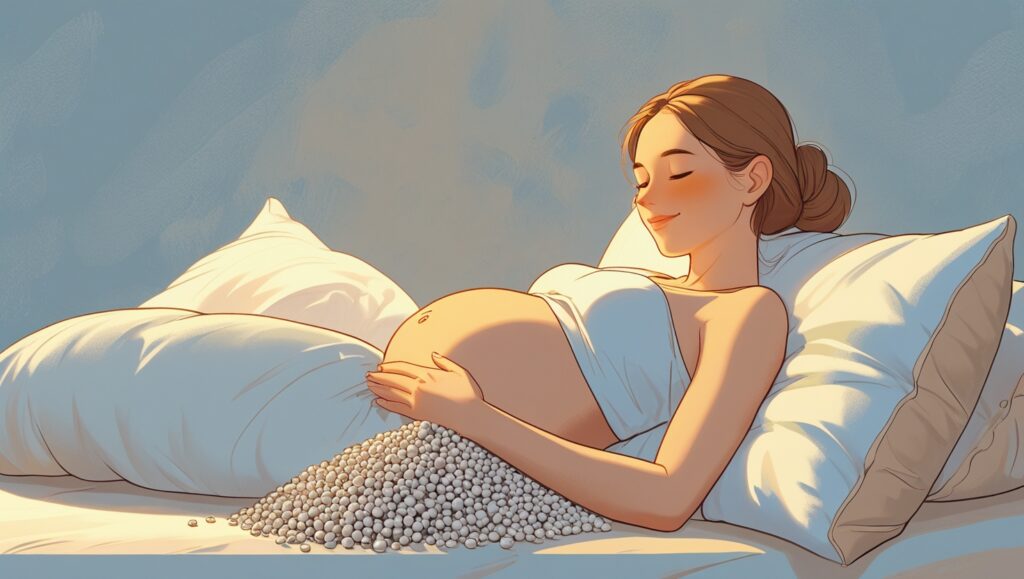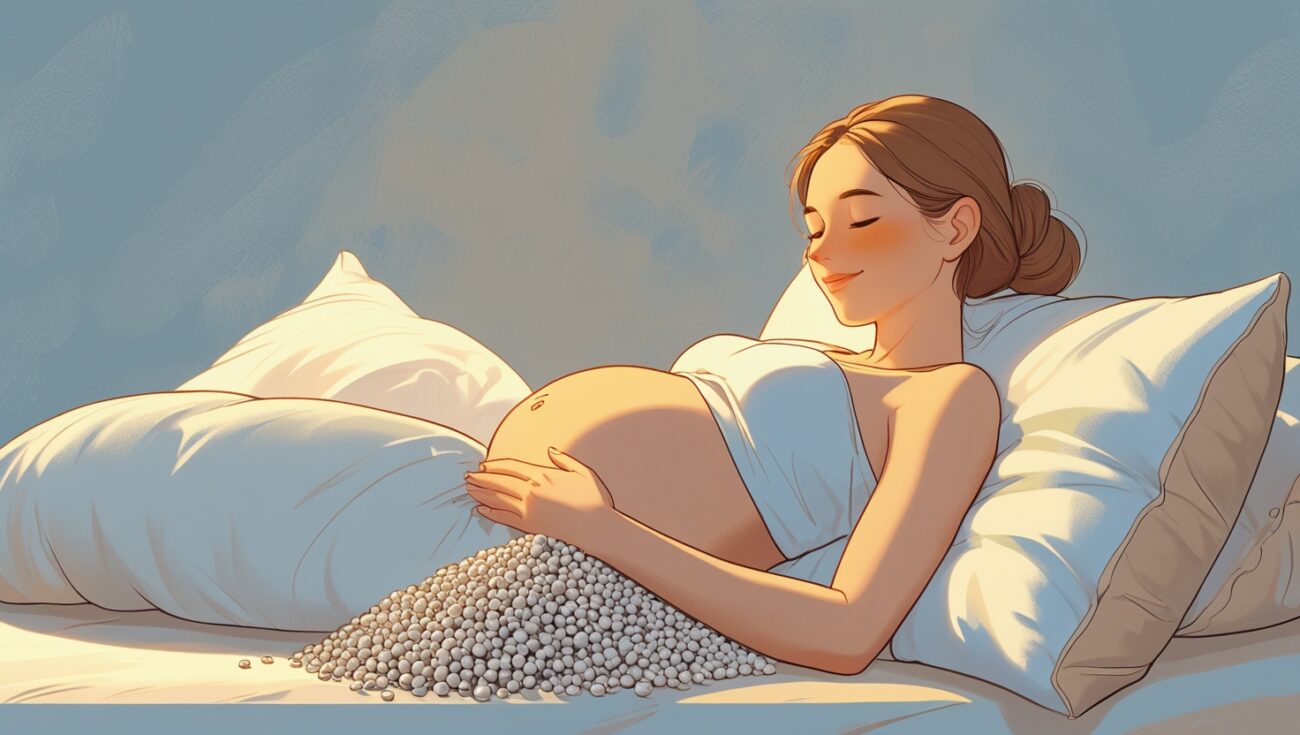How to Choose Between Memory Foam and Microbead Pregnancy Pillows
What I Wish I Knew Before Picking the Wrong One
When I first searched for a pregnancy pillow, I had no idea there were different types of filling—let alone how much that would impact my comfort. I thought a pillow was just a pillow. But trust me, choosing between memory foam and microbead pregnancy pillows makes a huge difference in how well you sleep and how supported your body feels.
Let me walk you through what I learned (the hard way), so you can pick the best pregnancy pillow for your needs—without wasting money or dealing with return hassles.

Table of Contents
What’s the Real Difference Between Memory Foam and Microbeads?
Memory Foam Pregnancy Pillows
Memory foam pillows are made from dense, contouring material that responds to your body heat and shape. These pillows provide firm, targeted support, especially around the lower back, hips, and belly. If you’re someone who needs structure and stability while you sleep, memory foam may be the way to go.
Check out this memory foam pregnancy pillow I found on Amazon
Microbead Pregnancy Pillows
Microbead pillows are filled with tiny polystyrene beads, making them ultra-flexible, lightweight, and super moldable. If you toss and turn a lot, or if you want something that feels like it’s “hugging” your shape without pushing back too hard, microbeads feel like a dream.
Here’s a microbead option I really liked
How I Tested Both (and Why It Matters)
I started with a memory foam pillow because I figured firm support meant better sleep. But after a few nights, I felt locked into one position. It didn’t adapt well when I wanted to shift from side to side, and I ended up waking up sore in my hips.
Then I tried a microbead pillow—and it was like sleeping in a soft cloud that adjusted to my every move. The downside? It didn’t provide quite enough back support when I was sitting upright on the couch or in bed.
That’s when I realized: the choice really depends on how you sleep, where you’ll use the pillow, and what stage of pregnancy you’re in.
Memory Foam: When It’s the Better Choice
- You suffer from lower back pain and need structured support
- You don’t move much while sleeping
- You plan to use your pillow mostly in bed
- You want something that retains its shape long-term
Microbeads: When They’re the Better Choice
- You toss and turn or shift sleep positions often
- You like a softer, squishier feel
- You want to use the pillow on the couch or lounging areas
- You’re early in pregnancy and need something lightweight and versatile
Still Can’t Decide? Consider a Hybrid
There are pregnancy pillows now that combine memory foam cores with microbead layers—giving you the structure of foam with the softness of beads. I wish I had known this earlier because I ended up using both types depending on the day and my comfort level.
Here’s a hybrid pillow that mixes both worlds
Final Thoughts: What Worked for Me
Personally, I used the microbead pillow during the day—it was easier to move around and fit better on my couch. At night, I’d swap to my memory foam pillow for deep, restorative sleep. That combination helped me survive pregnancy with less tossing, turning, and pain.
So, don’t overthink it—but do think about your sleep style. The best pregnancy pillow isn’t always about price or popularity… it’s about what actually works for you.
One thing I noticed right away was how much temperature regulation matters. Memory foam tends to retain heat, especially if you’re a naturally warm sleeper. I woke up sweating some nights until I switched to a bamboo pillowcase or added a fan. Microbead pillows, on the other hand, are more breathable and helped me stay cooler.
When I started experiencing swelling in my legs, the microbead pillow let me prop them up without adding pressure to my knees. I could adjust the beads to fit under my calves, something memory foam didn’t allow. The flexibility was a game-changer in the third trimester.
I also discovered that memory foam pillows hold their shape better over time. If you’re planning to use your pillow postpartum—for breastfeeding or even as a support cushion—a firmer foam option might give you more long-term value.
In contrast, microbead pillows can go flat if you use them heavily or lean on them daily. I had to fluff and shake mine often, which became a little annoying. But the tradeoff was worth it for the mobility and lighter feel.
Another factor I didn’t think about initially was noise. Microbeads can make a slight rustling sound when you shift around. It didn’t bother me much, but if you’re a light sleeper or sensitive to sounds, it’s something to keep in mind.
If you’re petite or sleep in a smaller bed, microbeads were easier to fold, compress, and store. The memory foam pillow took up half the bed, and my partner wasn’t thrilled. Switching to the microbead on nights I needed more space really helped.
During travel, memory foam was bulky and hard to carry, while my microbead option folded easily into a suitcase. For moms on the go or anyone planning weekend getaways while pregnant, microbeads win that round hands down.
Also, microbead pillows felt more intuitive for lounging on the couch. I could twist it into a donut shape or snake it around my back. The memory foam one was best reserved for staying in one position—which is great if you’re reading or watching TV in bed.
If you’re on a budget, you might find microbead pillows are more affordable, though that depends on the brand. Some memory foam options are pricier because they’re designed to last longer and resist flattening over time.
From a maintenance standpoint, memory foam pillows are harder to clean. You can’t just toss them in the washer. I had to spot-clean with a damp cloth, while my microbead one came with a removable, washable cover—something I wish all pillows had.
If you’re planning on nursing or bottle-feeding after birth, I found memory foam worked better for propping up my baby securely. It felt sturdier and gave me more confidence as a first-time mom.
Finally, the weight of the pillow is something I underestimated. Memory foam pillows are heavier, which means they don’t slide around easily—but that also made it harder to reposition them when I was already tired. Microbeads were much easier to move without effort.

